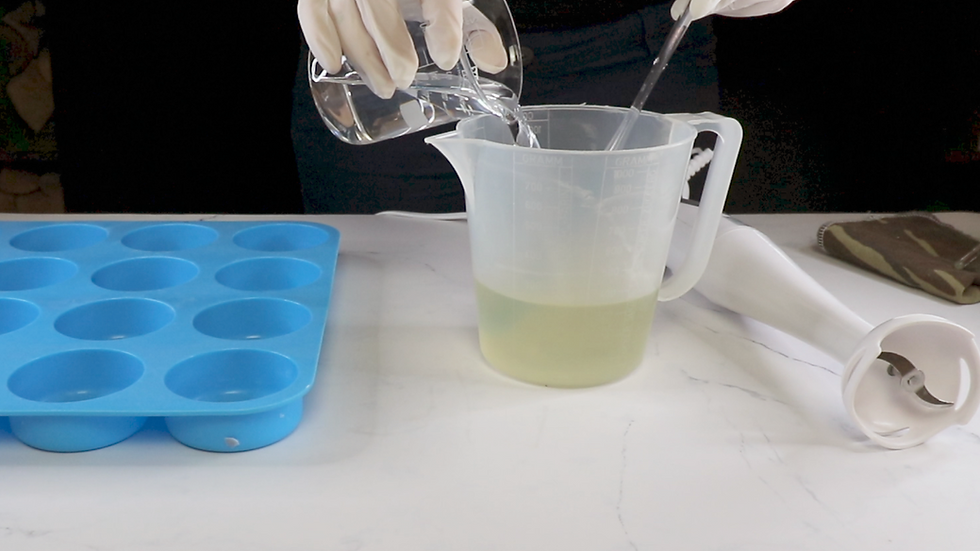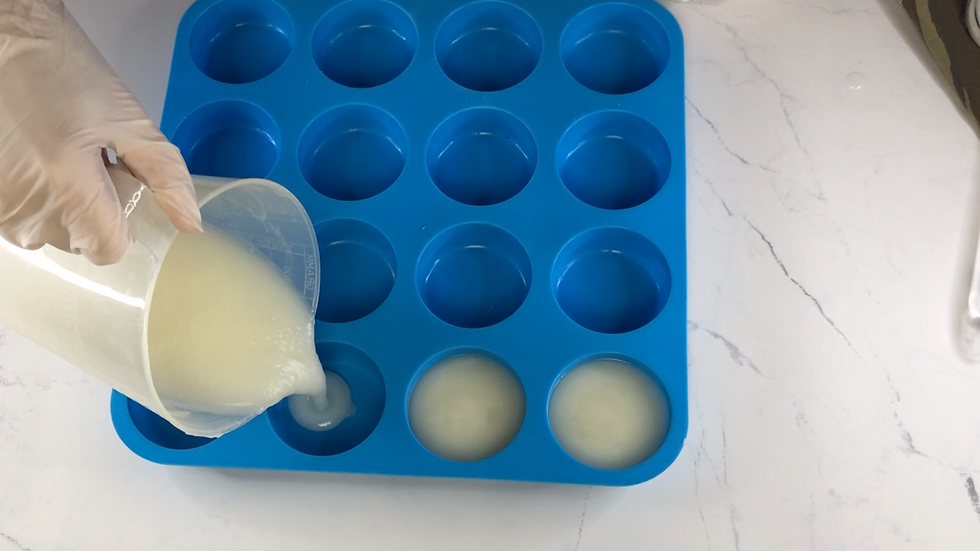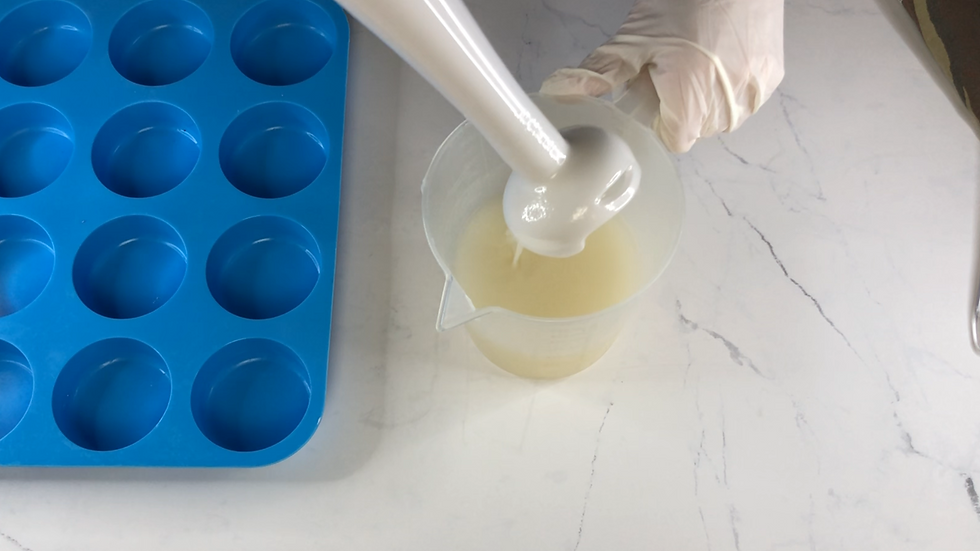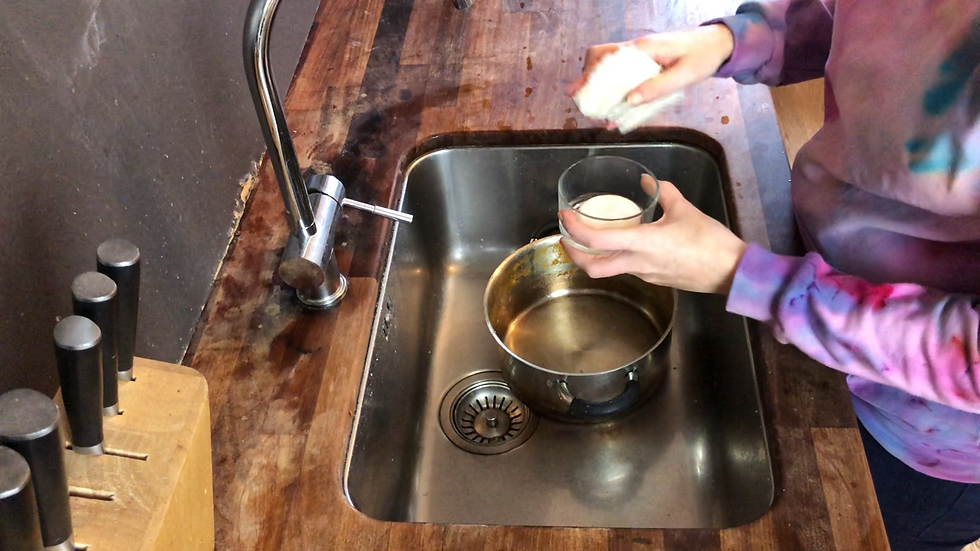DIY Dish Soap Made Easy: A Step-by-Step Guide for a Greener Clean
- Valinda

- Feb 4, 2022
- 9 min read
Updated: Apr 28, 2025
This turned out to be a rather long post as I wanted to include how to safely work with lye. If you already know this. Jump to the recipe.
How to do Eco-Friendly Dishes
By now you should know that washing your dishes is more eco-friendly compared to using disposable paper plates (as these require a lot of water to produce). But, is it possible to make your dishwashing routine more eco-friendly? Sure it is! Below you can read some tips to help you along the way.
Dishwasher
A dishwasher is about 3.5 times more water-efficient compared to washing dishes by hand. So, if you have the funds and space for a dishwasher, it is definitely a good investment to save water (and time).
You might think that a dishwasher completely fills up to the top with water, or sprays a constant stream of fresh water. But this is not the case. Dishwashers nowadays use lots of pumps, filters, and sprays that reuse water during cleaning. Clean water is only used at the beginning and for the final rinse. During washing, water is filtered and heated for maximum cleaning.
Even though I have a dishwasher, I also do the dishes by hand daily. Pots and pans I wash by hand as it enhances their longevity. Just like for some of the fancy kitchen knives we have. Also, some wooden kitchen supplies are washed by hand. Read here more tips to save water.

Sponge/brush
Nowadays, there are several sustainable options out there as alternatives to the plastic brushes and sponges we used to have. A wooden brush a great for those small glasses in which you can reach to bottom with a sponge. A loofah or a coconut scrub pad is a great compostable sponge. This not only saves you a lot of plastic, but they also last longer compared to their plastic counterpart saving you money in the long run.
Use less water
When I do the dishes by hand, I want to avoid filling the sink completely with water. I do that by using the largest pan I used that day as my sink and I do the dishes in that pan. This saves me lots of water and I find it easier to work with as I rinse next to the pan. Also, collect the cold ‘waste’ water and use the water to water plants.
Why solid dish soap
Plastic waste is one of the biggest problems our world has nowadays. It threatens climate, ocean, animal, and human health. It is shocking to know that up till now, over 200 different animals species (ranging from turtles to seals to birds) have been consuming our plastic waste.
Luckily, we have become more aware of the threat of single-use plastic and are willing to make a change.
Dishwashing liquid can also causes lots of packaging waste. As our population grows, we have more need for cleaning supplies and therefore need more household products which include dishwashing soap. Unfortunately, this soap often comes in a plastic bottle and while we are increasingly becoming better at recycling plastic, only about 8% of our plastic waste was recycled in 2018.
Especially when you know that 27 million tons of plastic ended up in landfills in 2018. These plastics were not recycled but incinerated. So, when using a block of solid dishwashing soap, we avoid plastics going to be incinerated.
Chemicals in liquid dishwashing soap
Next to their plastic packaging, liquid dishwashing soaps also contain lots of different chemicals. One of those chemicals can be Sodium Laureth Sulfate or SLES. This is mainly used as a foaming agent that can penetrate through grease and clean it from the surface of utensils. However, SLES can be absorbed by skin cells which may lead to rashes and allergic reactions if your skin is prone to that.
Next to that, it is known to be harmful to aquatic life in lab tests
Disodium EDTA is another chemical that is often used in dishwashing liquids. While on its own it is not toxic, it can enhance the penetration of other chemicals used in dish soap.
In addition to these chemicals, other also fragrances and colorants are used that add nothing to the functionality of the final product. It is just pleasant for the senses while it does not increase cleansing properties.
So, what can we do to avoid plastic and chemicals for our dishes? We create our own dishwashing soap! Want to know more about eco friendly dishwashing? Go to this blog post.
How to work with lye
If we want to make soap, oils need to be emulsified with lye as this starts the saponification process. Safety is very important during this process as we are working with lye, a potentially dangerous chemical. Sodium hydroxide or lye is an inorganic compound commonly found in drain cleaners. Sodium hydroxide lye is very caustic and can burn our skin. To avoid accidents, sodium hydroxide needs to be handled properly for our safety. However, because lye could be very harmful to our health, it’s important to take every safety measure when making cold process soap.
Sodium hydroxide is available in different forms, such as flakes, pellets, or powder. To make cold process soap, lye is added to (distilled) water. The sodium hydroxide dissolves and a lye solution is created. Mixing water and lye creates an exothermic reaction which caused the temperature to increase. The solution can become very hot and can also create fumes, which should not be inhaled.
Workplace
The area where you mix your lye solution should have good ventilation to avoid breathing in lye fumes. Mixing outside is an option but where I live weather often does not allow for this. I prepare my lye solution under the fume hood of my stove. Before I start I turn this on to the maximum setting so the fumes disappear fast. Keep kids, pets, and other distractions away from your soaping space to prevent accidents
Always Add Lye to Water (Never Water to Lye!): The first step in mixing lye is to measure the correct amount. Use weight measurements for measuring lye and don’t ‘wing it’ as you want to be as accurate as possible. Weight both water and lye in different beakers.
Slowly add your lye to the water. Never add water to your lye. This is because those first droplets of water that touch the lye will start to boil immediately which results in splashes and in worst cases an eruption of lye.
A popular rhyme for new soapmakers: “It’s smarter to add lye to water! Add water to lye and you may die!” It’s a bit extreme but it is helpful.
The right Mixing Container
As Sodium Hydroxide is very caustic, you need to use the right equipment. The container should be sturdy and heat-resistant plastic or glass. I don’t recommend using metal as the solution can get very hot and lye can react with some metals producing a hazardous reaction (aluminum and tin are known for this). To be safe, just avoid metal containers and find a sturdy plastic measuring cup a the thrift shop that you use only for lye making.
Nowadays, I use glass lab equipment to prepare the solution. I want to be extra safe so I place this glass beaker in a plastic beaker in case there are any spills.

Safety gear
When working with lye you need to protect yourself. This includes eye goggles, gloves, long sleeves, and long pants. Covering your skin helps protect it from drops of lye solution that might splash around when preparing the lye solution. Some soaper makers wear a mask while preparing the lye to avoid breathing in any fumes. If you have long hair, put everything out of the way in a hair tie.
If You Get Lye on Your Skin
According to the MSDS (Material Safety Data Sheet), remove any contaminated clothing if your skin comes in contact with lye and flush immediately with plenty of water for at least 15 minutes. Seek medical attention afterward. If it comes in contact with the eyes, flush immediately with water for at least 15 minutes and get medical attention. If inhaled, move to fresh air.
Note: don’t use vinegar with lye spills as this creates a chemical reaction that could make it worse.
So, now that we know how to work with lye safely, it is time to start making soap.
How to make Homemade Dish Soap
Ingredients
Only 3 ingredients are needed to make Homemade Dish Soap: Coconut oil, distilled water, and sodium hydroxide.
In the recipe in the video above I use:
290 grams Coconut oil
110 grams Demineralized water
52 grams Lye
Calculated at 2% Superfat. I use SoapCalc to measure how much water and lye I need.
Equipment
Safety gear
Plastic measuring cups or glass beakers.
Stirring tools (glass or plastic) (I use glass rods)
Digital scale
Instructions
Step 1:
Carefully measure all 3 of the ingredients in 3 separate glass or plastic containers. Do this on an accurate digital scale.
Step 2:
Prepare a place to make your lye solution. I do this on the stove (which I will NOT be using) so I can work under the fume hood.
Step 3:
Put on all safety gear.
Step 4:
Slowly and carefully add the sodium hydroxide to the distilled water. Keep stirring until everything is dissolved. Careful as this solution can become very hot.
Step 5:
Let the lye solution cool for a bit until the beaker is warm but no longer hot. The cooler the better as this is easier to work with.
Step 6:
Melt the coconut oil in a plastic or glass container. Make sure it is big enough for the entire soap batter and leave some extra space for mixing.
Step 7:

Add the cooled lye to the melted coconut oil.
Step 8:
Use your stick blender to properly mix.
Step 9:
Mix until trace.
Step 10:
Pour the soap batter into your soap mold.

Step 11:
Demold after 24 hours.
Step 12:
Place your soap in a cool dry place for at least a week to harden.
What is trace?

Soapmakers use the term ‘come to trace’ to describe the consistency of the soap batter. When the soap has come to trace, it means it is ready to be poured into molds.
But what does that mean? Coming to trace means that the saponification process of the soap has started and this shows a visible cue, the trace. When a soap begins to thicken and shifts from clear and very liquid to more opaque and thicker (the soap should come from your stick blender in a thick stream instead of droplets and the top of your batter should hold its shape a little) you have achieved trace. The difficult part is that this is not an exact science and the more you make soap, the better you get a feel for this.
Also, the level of trace can differ which depends on the oils you used to make your soap and on the temperature of your lye and oils. The warmer your soap batter the more quickly, your soap comes to trace as heat accelerates the saponification process of your batter.
Mixing your batter until it reaches a heavy trace (a very thick batter) allows for layering soap of different colors since it holds its shape to support additional layers. While a thinner trace is preferred if you have a soap mold that has lots of detail with small crevices that need to be filled.
How to use Homemade Dish Soap
After you have patiently waited for a couple of weeks for the bar to harden, you can finally use it on your dishes.
You can’t make soapy water with a solid dishwashing soap like you would with liquid dishwashing soap. So we have to use this soap a little differently.
I wet my loofah sponge and scrub over my dish soap to get the sponge nice and soapy. When you do this for the first time with new soap, this might take a bit longer. I wet the plate or pan (or whatever you want to clean) and use the sponge to clean its surface. When it is sufficiently clean, I give it a rinse and towel dry the dishes.

How to store Homemade Dish Soap
To enjoy your soap for as long as possible, store the dishwashing soap dry when you are not using it. If you store it in a container next to your sink (like I do), pour off all the excess liquid after doing the dishing to prevent your bar from getting soggy.
Essential oils
I have not used essential oils in this recipe and this is not an accident as I am not a fan of essential oils for 2 reasons.
The first one is that the production of essential oils is extremely wasteful. For example, it requires about 242,000 rose petals to produce approximately 5 mL of rose essential oil.
While more sustainable alternatives have been discovered for the production of citrus essential oil where they use fruit waste for the essential oil production. Most essential oil production is extremely wasteful.
The second reason I am not a fan is the fact that the plant matter has different active compounds depending on the season, the climate and even farming practices . And there is also the degradation process depending on the age of the essential oil. This all could result in different properties of the essential oil with each new batch your purchase. Therefore it is even possible to have a skin reaction to one batch while the previous batch was fine. To avoid all these inconsistencies, I avoid using essential oils.
Not suitable for hair
This block of soap is designed with the purpose of doing the dishes in mind. Meaning that this soap bar is very hard (solid) with great cleansing properties. This has the downside that it is a bit drying which makes it unsuitable to wash your hair with. This recipe is a great one it you are interested in DIYing a shampoo bar for your hair.


















Comments